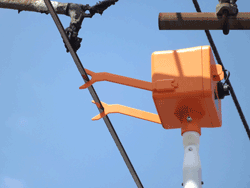Railway power cameras to reduce delays and costs
Posted: 25 August 2011 | | No comments yet
Spotting a defect on an overhead rail wire upto 25ft above your head can be tricky…


Overhead line maintenance camera
Spotting a defect on an overhead rail wire upto 25ft above your head can be tricky even to the expert eye but new camera technology, which has been rolled out to rail teams across Britain, will mean more efficient and more accurate maintenance, fewer delays to passenger and freight services and save millions of pounds in delay payments.


Overhead line maintenance camera
Following a successful trial, Network Rail has supplied 30 cameras to maintenance delivery units on electrified routes across the country. A huge benefit is that engineers can safely operate the cameras without turning off the power and closing the line – a huge time saver.
When out on routine track patrols, engineers can attach the camera to the overhead wire and it is then held steady by two small stabilising arms on insulated poles. The camera can tilt so that images and video of the top and side of the wire can also be seen. High resolution images are instantly captured and streamed to a portable laptop. Engineers can view this for instant review of the condition of the wire and equipment components or analyse the footage back in the delivery unit. A schedule for repair of any defects can then be put in place.
Steve Featherstone, director of maintenance for Network Rail said: “When the overhead wires come down, it can cause massive delays to passengers and freight services and can cost Network Rail millions of pounds each year in compensation. We’ve been looking at smarter ways to reduce such incidents by using technology to help us find faults and fix them before they become a problem.
“The cameras give us a greater field of vision than the naked eye and this allows our teams to be less reactive and build this maintenance into our schedules, which will mean fewer closures of lines, fewer delays and a better value railway for everyone.”
During testing, the camera was able to stream images to a laptop over 100 metres away, enabling a greater area to be covered at one time. Another benefit of the camera is that it can measure the thickness of the contact wire so engineers can gauge wear rates, find thin spots and then plan either contact wire renewals using real time wire wear calculators and small piece replacements to prevent dewirements from contact wire coming apart.



